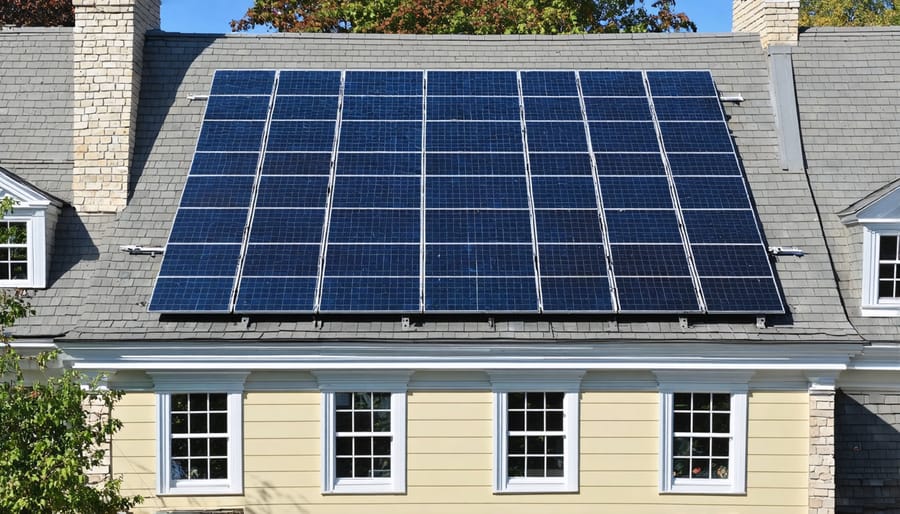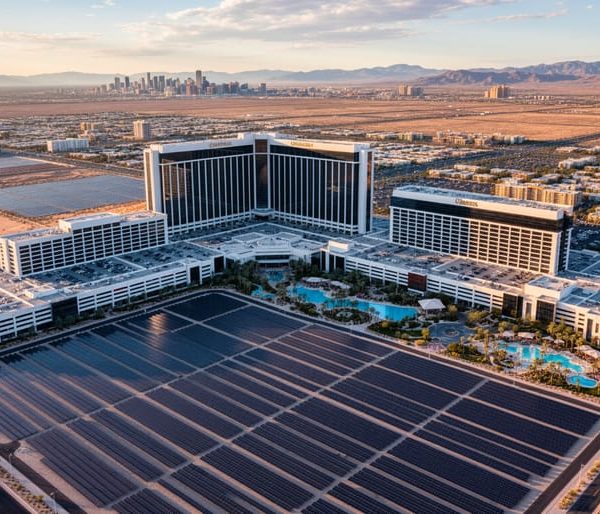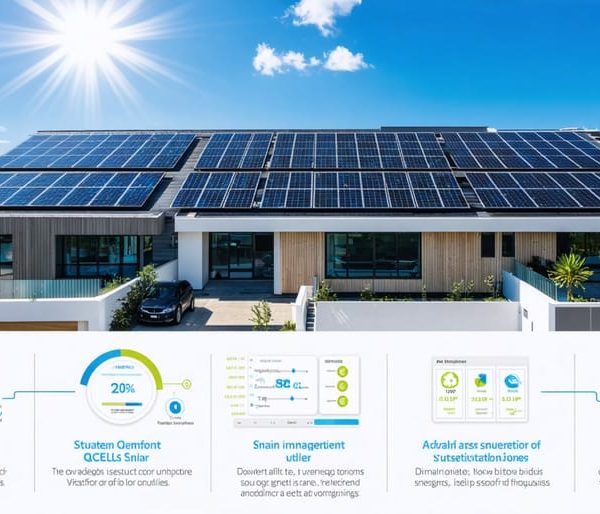Solar Panels That Preserve Historic Charm: Smart Solutions for Protected Buildings
Balancing solar energy’s promise with historic preservation isn’t just possible – it’s happening successfully across America’s most cherished historic districts. From Boston’s Beacon Hill to Charleston’s French Quarter, property owners are discovering innovative ways to embrace clean energy while protecting architectural heritage.
Modern solar technology offers elegant solutions specifically designed for historic properties. Low-profile panels, solar shingles, and rear-facing installations allow homeowners to generate clean power without compromising their building’s historic character. These adaptable systems can be thoughtfully integrated into slate roofs, hidden behind parapets, or installed on less visible elevations.
The key lies in early collaboration with preservation boards and solar experts who understand both worlds. Many historic districts have already established clear guidelines for solar installation, creating predictable paths for approval. Success stories show that with careful planning and the right approach, historic properties can achieve energy independence while maintaining their irreplaceable architectural features.
For property owners ready to explore solar options, the process starts with understanding local preservation guidelines and partnering with installers experienced in historic retrofits. This balanced approach ensures that tomorrow’s energy needs can be met while preserving yesterday’s architectural treasures.
Understanding Historic District Regulations
Key Preservation Requirements
Historic districts typically require solar panel installations to maintain the architectural integrity of protected buildings while embracing renewable energy solutions. The most common preservation requirements include ensuring panels are not visible from the primary street view and maintaining the original roofline’s appearance. Many districts mandate that panels be installed parallel to and within inches of the roof surface, avoiding raised or tilted installations that could alter the building’s profile.
Color matching is often crucial, with districts preferring black or dark-colored panels and mounting systems that blend with existing roof materials. Some areas require panels to be positioned on rear-facing slopes or hidden behind architectural features like parapets or dormers. Installation must not damage or permanently alter historic materials, and all mounting systems should be reversible.
Most preservation boards also require detailed documentation, including installation plans, panel specifications, and visual simulations showing the panels’ impact on the building’s historic character. Working with solar installers who have experience in historic districts can help ensure compliance while maximizing energy production within these guidelines.
Getting Approval for Solar Installation
Getting approval for solar installation in a historic district involves a systematic approach that respects both environmental goals and preservation requirements. Start by contacting your local historic preservation office to understand specific guidelines and restrictions. Most districts require you to submit detailed plans showing panel placement, mounting systems, and visual impact from street level.
Next, prepare a comprehensive application package including photographs of your property, technical specifications of the proposed solar system, and architectural drawings. Many preservation boards appreciate seeing photographic simulations that demonstrate how the panels will look once installed.
Schedule a preliminary meeting with the preservation board to discuss your plans. They may suggest modifications like using lower-profile panels or adjusting placement to minimize visibility from public areas. Be prepared to explain how your installation will protect the building’s historic character.
Once you receive initial feedback, work with your solar installer to revise plans as needed. Submit your final application with all required documentation and attend the formal review meeting. Remember that persistence and flexibility are key – if your first proposal isn’t approved, most boards are willing to work with homeowners to find acceptable solutions.
Innovative Solar Solutions for Historic Buildings
Low-Profile Solar Panels
Modern innovations in solar technology have made it possible to maintain the historical charm of your property while harnessing clean energy. Low-profile solar panels offer an elegant solution for homeowners in historic districts who want to embrace renewable energy without compromising their building’s architectural integrity.
These sleek panels sit just inches above your roofline, creating minimal visual impact from street level. Many manufacturers now produce panels that are up to 40% thinner than traditional models, while still delivering impressive energy output. Some designs even incorporate non-reflective solar panels that reduce glare and blend seamlessly with existing roofing materials.
Color-matched frames and mounting systems further help these panels integrate with historical aesthetics. Some manufacturers offer panels in various shades, including slate gray and terra cotta, to complement traditional roofing materials. The mounting hardware can be concealed behind the panels, creating a clean, unobtrusive appearance that preservation boards often prefer.
Recent installations in historic districts across the country have demonstrated how these low-profile systems can meet strict preservation guidelines while providing substantial energy benefits. Many homeowners report that these panels are barely noticeable from the street, yet they generate enough power to significantly reduce their monthly energy bills.
Solar Tiles and Slates
Solar tiles and slates represent a groundbreaking solution for homeowners in historic districts who want to embrace solar energy while maintaining their property’s traditional appearance. These innovative products are designed to seamlessly blend with existing roofing materials, making them virtually indistinguishable from conventional tiles and slates.
Unlike standard solar panels, these specialized alternatives come in various styles that mimic traditional roofing materials, including classic slate, terracotta, and Victorian-era tiles. The solar cells are integrated directly into the roofing material, creating a uniform, aesthetically pleasing appearance that often satisfies even the strictest historic preservation guidelines.
Many manufacturers now offer solar tiles in different colors and textures to match specific architectural periods. For instance, some products perfectly replicate the weathered look of century-old slate roofs, while others capture the distinctive appearance of clay tiles common in Mediterranean-style historic homes.
Installation is typically more complex than traditional solar panels and requires specialized expertise. However, the end result offers dual benefits: a watertight roof and clean energy generation. While solar tiles generally cost more than conventional panels, they often receive easier approval from historic preservation boards and can potentially increase property value due to their seamless integration.
For maximum authenticity, some homeowners choose to install a combination of solar and non-solar tiles, allowing for strategic placement that optimizes both energy generation and historic preservation requirements.
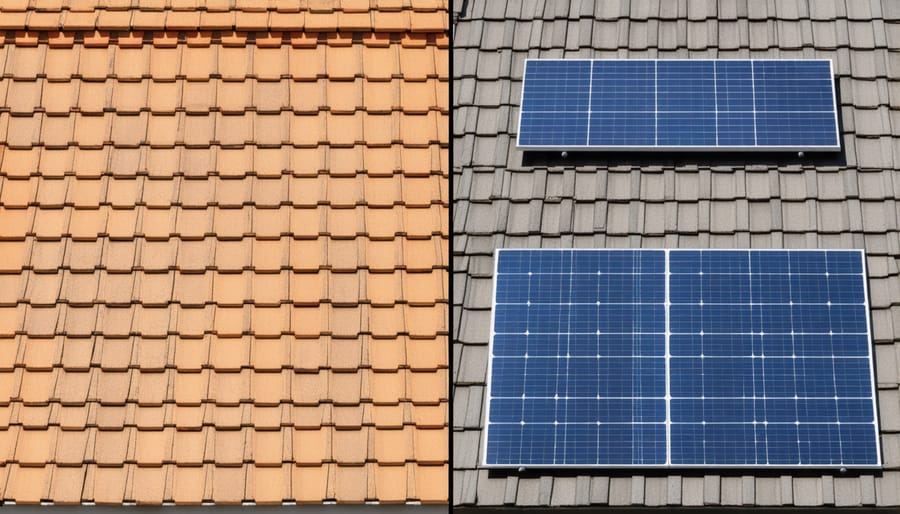
Alternative Placement Strategies
When working with historic properties, creative placement strategies can help you harness solar power while preserving architectural integrity. Ground-mounted solar arrays in less visible areas of your property offer an excellent alternative to roof installations. These systems can be strategically positioned behind existing structures or screened with period-appropriate landscaping.
Carport and pergola installations present another innovative solution. By incorporating solar panels into newly constructed period-appropriate structures, you can generate clean energy while adding functional outdoor spaces. These installations often face less scrutiny from historic preservation boards since they don’t alter existing structures.
For properties with outbuildings like garages or barns, these secondary structures make ideal locations for solar panels. They typically have less historical significance and are often less visible from the street, making them perfect candidates for solar installation.
Consider solar awnings that complement your building’s historic character. These can be designed to match original architectural elements while providing both shade and power generation. Some homeowners have successfully integrated solar panels into restored widow’s walks or historic balustrades, maintaining period aesthetics while embracing modern technology.
Remote solar gardens offer another possibility. Some historic districts allow property owners to participate in community solar projects, generating clean energy off-site while preserving their historic buildings exactly as they are.
Remember to document how your chosen placement strategy maintains the property’s historic character when presenting plans to preservation boards.
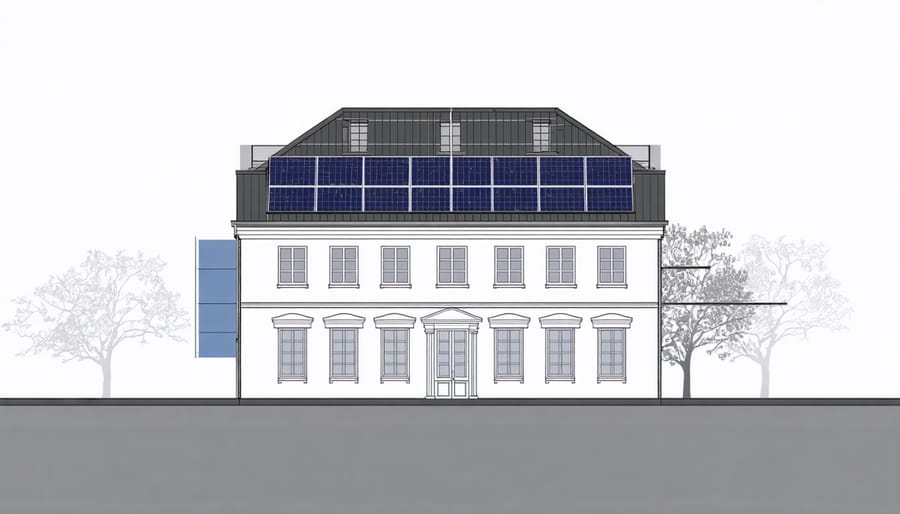
Success Stories and Case Studies
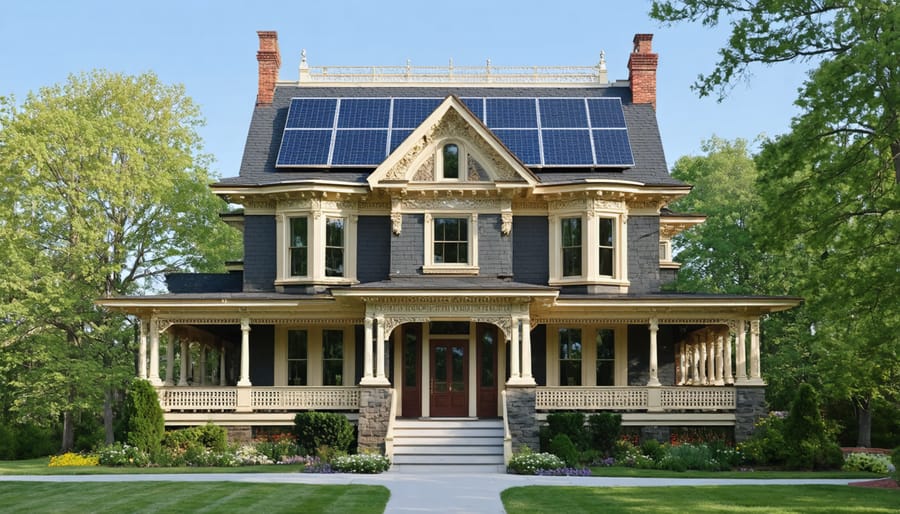
Victorian Home Solar Integration
The Brown family’s 1890s Victorian home in Boston’s Beacon Hill district showcases how modern solar technology can harmoniously blend with historical architecture. Working closely with preservation specialists and solar installers, they successfully integrated a 6.4kW solar array that remains virtually invisible from street level.
The installation team used all-black panels with a specialized mounting system that follows the steep pitch of the original slate roof. They positioned the panels behind the decorative dormer windows and utilized the home’s distinctive mansard roof design to naturally conceal the array while maximizing solar exposure.
“We were initially concerned about maintaining our home’s historical character,” says homeowner Sarah Brown. “But the final result exceeded our expectations. The panels are barely noticeable, and we’ve reduced our energy bills by 70%.”
The project required careful planning to protect the original slate roofing. Installers used custom flashing and mounting hardware designed specifically for historic buildings. They also incorporated micro-inverters instead of a central inverter, allowing for a more discreet installation without compromising the home’s period aesthetics.
The Browns’ success has inspired several neighboring homeowners to pursue similar installations, demonstrating that historic homes can embrace renewable energy while preserving their architectural integrity. Their installation passed all historical commission reviews and now serves as a model for other Victorian home solar projects.
Historic Commercial Building Transformation
The Johnson & Sons Building in downtown Portland serves as a shining example of how historic commercial properties can successfully embrace solar technology while maintaining their architectural integrity. Built in 1892, this three-story brick building recently underwent a remarkable transformation that caught the attention of both preservationists and renewable energy advocates.
The building’s owners worked closely with local historic preservation boards and solar installation experts to develop an innovative solution. They installed 76 solar panels using a ballasted mounting system on the flat roof, keeping them completely hidden from street view while maximizing energy production. The panels were arranged in a way that avoided any structural modifications to the building’s historic fabric.
The installation now generates approximately 45% of the building’s electrical needs, resulting in annual energy savings of $12,000. What makes this project particularly noteworthy is how it incorporated modern monitoring technology behind the building’s original facade. The energy management system was seamlessly integrated into the existing electrical infrastructure without disturbing the historic interior features.
“We wanted to prove that historic buildings can be both preserved and sustainable,” says Sarah Johnson, the building’s owner. “The key was finding the right balance and working with experts who understood both historic preservation and solar technology.” The project has since become a model for other commercial property owners in historic districts, demonstrating that with careful planning and the right approach, solar integration can respect historical authenticity while delivering significant environmental and economic benefits.
Best Practices for Implementation
Working with Preservation Boards
Working with preservation boards doesn’t have to be intimidating. The key to success lies in early engagement and thorough preparation. Start by researching your local preservation board’s guidelines and scheduling an initial consultation before sizing your solar system or making any concrete plans.
Prepare a comprehensive proposal that demonstrates how your solar installation will respect the historic character of your property. Include detailed drawings, photos of similar successful installations, and specifications of low-profile panels and mounting systems. Many boards appreciate seeing mock-ups or simulations showing how the panels will look from street level.
Consider these proven strategies for approval:
– Present multiple installation options that minimize visibility from public areas
– Choose panels with anti-glare coatings and black frames that blend with traditional roofing
– Propose removable mounting systems that won’t permanently alter historic structures
– Include documentation of how similar projects have succeeded in other historic districts
Remember to emphasize your commitment to preservation while highlighting the environmental benefits. Many preservation boards now recognize that sustainable energy solutions can coexist with historic preservation goals. Being patient, professional, and willing to compromise often leads to mutually satisfactory solutions.
Stay positive throughout the process and be prepared to make adjustments based on board feedback. Success stories from other homeowners in your district can be valuable additions to your presentation.
Maintaining Historic Character
When adding solar panels to historic properties, preserving architectural character is essential. Modern solar installations can be thoughtfully integrated while maintaining the building’s historic integrity through several proven strategies.
Consider low-profile panels that sit flush with the roofline to minimize visual impact. Many manufacturers now offer sleek, all-black panels that blend seamlessly with traditional roofing materials. Position panels on less visible roof sections, such as rear-facing slopes or areas hidden from street view. This approach maintains the property’s historic facade while still capturing optimal sunlight.
Solar tiles and shingles offer an excellent alternative to traditional panels. These innovative products mimic the appearance of historic roofing materials while generating clean energy. Though typically more expensive, they provide an elegant solution for properties where maintaining period authenticity is paramount.
Work with installers experienced in historic properties who understand preservation requirements. They can recommend appropriate mounting systems and panel layouts that minimize structural modifications. Consider removable installation methods that won’t permanently alter the building’s historic features.
Color matching and careful placement of conduit and electrical equipment help maintain visual harmony. Where possible, route cables through existing openings or less conspicuous areas. Remember that successful integration often requires collaboration with local preservation boards and careful attention to architectural details.
Embracing solar technology in historic districts doesn’t mean sacrificing architectural heritage – it’s about finding the perfect balance between preservation and progress. As we’ve explored, innovative mounting solutions, careful panel placement, and reversible installation methods make it possible to enjoy clean energy while maintaining historical integrity. By working closely with preservation boards and choosing appropriate solar solutions, property owners can reduce their carbon footprint while protecting the character of their historic buildings. Remember, every successful solar installation in a historic district paves the way for others, creating a future where sustainable energy and architectural preservation work hand in hand. Together, we can power our historic neighborhoods with clean energy while ensuring these treasured buildings continue to tell their stories for generations to come.

